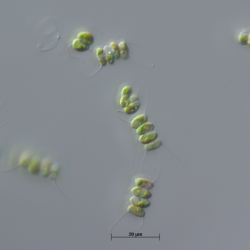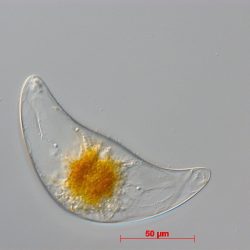Cultures for schools – Darwin Biological
CCAP is partnered with Darwin Biological to supply cultures of algae and protozoa to UK schools.
Darwin Biological supply a wide range of high quality live and preserved specimens, with over 50 years of professional experience in the school science supplies industry, and we are proud to be a collaborator.
Schools can choose from 14 strains, including Scenedesmus quadricauda, a quick growing green algae ideal for pollution, eutrophication and photosynthesis experiments, such as the popular ‘algae wrapped in jelly balls‘ experiment; and Pyrocystis lunula, a bioluminescent marine dinoflagellate.


Culture information:
We send out an information sheet with each culture, these can also be found below:
ooking after your Amoeba borokensis.
These large amoebas are best kept in in tissue culture flasks lying on their side as they prefer to attach themselves to the larger surface area. The cells can be seen in the flask using an inverted microscope.
They are kept in PC (Prescott’s & Carrier’s) medium
The tissue culture flask has been overfilled to protect the amoebas during posting and the contents will need to be split into another flask on arrival.
The amoebas graze on Tetrahymena pyriformis and each flask will need 8 drops of the provided Tetrahymena once a week. Please note that they would have been ‘fed’ on the day of transit. Do not overfeed the culture.
For long term maintenance of this culture, it will need to be subcultured every 8 weeks and fed Tetrahymena weekly.
Looking after your Aristerostoma sp.
These ciliates are best kept in in tissue culture flasks. The cells can be seen in the flask using an inverted microscope at x20, for observation use x40, or x60 if available.
They are kept in f/2 marine medium – with a boiled wheat grain added to encourage growth of the bacteria on which the ciliate feeds.
Aristerostoma is also algivorous and can be fed with a few drops of Nannochloropsis or Isochrysis algae.
For long term maintenance of this culture, it will need to be subcultured every 4 weeks. The ciliates settle to the bottom of the flask where they feed on the bacteria; before subculturing use a sterile pipette to gently mix the culture then add around 5ml to around 25ml fresh sterile medium with a wheat grain that has been boiled for 1-2 minutes and cooled.
Looking after your Blepharisma americanum
This freshwater ciliate protozoa is grown in SES medium
If the culture is not to be used within a couple of days of receipt we advise transferring the culture to a larger sterile container to provide air space.
For long term maintenance of this culture, keep at room temperature, out of direct sunlight (cultures don’t need light) and subculture every five weeks or whenever the culture has grown dense.
Subculture by gently agitating the flask/petri dish to mix the cells evenly, then inoculate culture aseptically into fresh sterile medium in the ratio of roughly 1:10 (culture:medium) by pouring or pipetting.
Add a couple of boiled wheat grains to each culture to encourage growth of the bacteria this ciliate feeds on.
Looking after your Chlorella vulgaris
These freshwater green algae are grown in EG:JM media
If the culture is not to be used within a couple of days of receipt we advise transferring the culture to a larger sterile container to provide air space.
For long term maintenance of this culture, keep at room temperature, out of direct sunlight, and subculture every four weeks or whenever the culture has grown dense.
Subculture by inoculating culture aseptically into fresh sterile medium in the ratio of 1:10 (culture:medium) by pouring or pipetting. EG:JM medium is nutrient-rich so note that any bacteria or fungi that gets into the culture will also grow well. Other general freshwater media can also be used but growth may be a little slower.
Looking after your Coscinodiscus radiatus
These marine diatoms are grown in f/2+Si medium
If the culture is not to be used within a couple of days of receipt we advise transferring the culture to a larger sterile container to provide air space.
For long term maintenance of this culture, keep at room temperature, out of direct sunlight, and subculture every four weeks or whenever the culture has grown dense. In our experience diatoms do not grow well under standard white LED lights which may not contain enough red light.
Subculture by inoculating culture aseptically into fresh sterile medium in the ratio of 1:10 (culture:medium) by pouring or pipetting. EG:JM medium is nutrient-rich so note that any bacteria or fungi that gets into the culture will also grow well. Other general freshwater media can also be used but growth may be a little slower.
Looking after your Crucigenia tetrapedia
This freshwater green algae is grown in 3N-BBM+V media
If the culture is not to be used within a couple of days of receipt we advise transferring the culture to a larger sterile container to provide air space.
For long term maintenance of this culture, keep at room temperature, out of direct sunlight, and subculture every four weeks or whenever the culture has grown dense.
Subculture by inoculating culture aseptically into fresh sterile medium in the ratio of 1:10 (culture:medium) by pouring or pipetting.
Looking after your Euglena gracilis.
This motile freshwater euglenozoa is grown in EG:JM media
If the culture is not to be used within a couple of days of receipt we advise transferring the culture to a larger sterile container to provide air space.
For long term maintenance of this culture, keep at room temperature, out of direct sunlight, and subculture every four weeks or whenever the culture has grown dense.
Subculture by inoculating culture aseptically into fresh sterile medium in the ratio of 1:10 (culture:medium) by pouring or pipetting. EG:JM medium is nutrient-rich so note that any bacteria or fungi that gets into the culture will also grow well.
Looking after your Haematococcus lacustris
These freshwater green algae are grown in EG:JM media
If the culture is not to be used within a couple of days of receipt we advise transferring the culture to a larger sterile container to provide air space.
For long term maintenance of this culture, keep at room temperature, out of direct sunlight, and subculture every four weeks or whenever the culture has grown dense.
Subculture by inoculating culture aseptically into fresh sterile medium in the ratio of 1:10 (culture:medium) by pouring or pipetting. EG:JM medium is nutrient-rich so note that any bacteria or fungi that gets into the culture will also grow well. Other general freshwater media can also be used but growth may be a little slower.
Looking after your Paramecium bursaria
This freshwater ciliate protozoa contains symbiotic green algae, and is grown in SES:Volvic medium (a 3:1 mix of SES medium and Volvic mineral water)
If the culture is not to be used within a couple of days of receipt we advise transferring the culture to a larger sterile container to provide air space.
For long term maintenance of this culture, keep at room temperature, out of direct sunlight, and subculture every six weeks or whenever the culture has grown dense.
Subculture by gently agitating the flask/tube to mix the cells evenly, then inoculating culture aseptically into fresh sterile medium in the ratio of roughly 1:10 (culture:medium) by pouring or pipetting.
Looking after your Pseudopediastrum boryanum
This freshwater green algae is grown in MWC medium
If the culture is not to be used within a couple of days of receipt we advise transferring the culture to a larger sterile container to provide air space.
For long term maintenance of this culture, keep at room temperature, out of direct sunlight, and subculture every four weeks or whenever the culture has grown dense.
Subculture by inoculating culture aseptically into fresh sterile medium in the ratio of 1:10 (culture:medium) by pouring or pipetting.
Looking after your Pyrocystis lunula
This bioluminescent marine dinoflagellate algae is grown in L1 medium
If the culture is not to be used within a couple of days of receipt we advise transferring the culture to a larger sterile container to provide air space.
For long term maintenance of this culture, keep at room temperature, out of direct sunlight, and subculture every four weeks or whenever the culture has grown dense.
Subculture by inoculating culture aseptically into fresh sterile medium in the ratio of 1:10 (culture:medium) by pouring or pipetting.
See also our Bioluminescent Algae Information Sheet.
Looking after your Scenedesmus quadricauda
These freshwater green algae are grown in EG:JM media
If the culture is not to be used within a couple of days of receipt we advise transferring the culture to a larger sterile container to provide air space.
For long term maintenance of this culture, keep at room temperature, out of direct sunlight, and subculture every four weeks or whenever the culture has grown dense.
Subculture by inoculating culture aseptically into fresh sterile medium in the ratio of 1:10 (culture:medium) by pouring or pipetting. EG:JM medium is nutrient-rich so note that any bacteria or fungi that gets into the culture will also grow well. Other general freshwater media can also be used but growth may be a little slower.
Looking after your Spirulina subsalsa
This marine filamentous cyanobacteria is grown in ASW:BG media
If the culture is not to be used within a couple of days of receipt we advise transferring the culture to a larger sterile container to provide air space.
For long term maintenance of this culture, keep at room temperature, out of direct sunlight, and subculture every four weeks or whenever the culture has grown dense. We find that cyanobacteria can be adversely affected by lighting that is too bright, watch out for the culture turning pale.
Subculture by inoculating culture aseptically into fresh sterile medium in the ratio of 1:10 (culture:medium) by pouring or pipetting.
Looking after your Toxarium undulatum
These marine diatoms are grown in f/2+Si medium
If the culture is not to be used within a couple of days of receipt we advise transferring the culture to a larger sterile container to provide air space.
For long term maintenance of this culture, keep at room temperature, out of direct sunlight, and subculture every four weeks or whenever the culture has grown dense. In our experience diatoms do not grow well under standard white LED lights which may not contain enough red light.
Subculture by inoculating culture aseptically into fresh sterile medium in the ratio of 1:10 (culture:medium) by pouring or pipetting. EG:JM medium is nutrient-rich so note that any bacteria or fungi that gets into the culture will also grow well. Other general freshwater media can also be used but growth may be a little slower.

